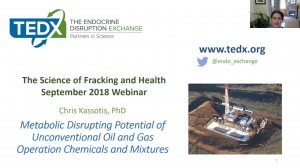From an ABSTRACT by Katherine E. Pelch, Environmental Heath Journal, 2018
Background— In the last decade unconventional oil and gas (UOG) extraction has rapidly proliferated throughout the United States (US) and the world. This occurred largely because of the development of directional drilling and hydraulic fracturing which allows access to fossil fuels from geologic formations that were previously not cost effective to pursue. This process is known to use greater than 1,000 chemicals such as solvents, surfactants, detergents, and biocides. In addition, a complex mixture of chemicals, including heavy metals, naturally-occurring radioactive chemicals, and organic compounds are released from the formations and can enter air and water. Compounds associated with UOG activity have been linked to adverse reproductive and developmental outcomes in humans and laboratory animal models, which is possibly due to the presence of endocrine active chemicals.
Methods— Using systematic methods, electronic searches of PubMed and Web of Science were conducted to identify studies that measured chemicals in air near sites of UOG activity. Records were screened by title and abstract, relevant articles then underwent full text review, and data were extracted from the studies. A list of chemicals detected near UOG sites was generated. Then, the potential endocrine activity of the most frequently detected chemicals was explored via searches of literature from PubMed.
Results — Evaluation of 48 studies that sampled air near sites of UOG activity identified 106 chemicals detected in two or more studies. Ethane, benzene and n-pentane were the top three most frequently detected. Twenty-one chemicals have been shown to have endocrine activity including estrogenic and androgenic activity and the ability to alter steroidogenesis. Literature also suggested that some of the air pollutants may affect reproduction, development, and neurophysiological function, all endpoints which can be modulated by hormones. These chemicals included aromatics (i.e., benzene, toluene, ethylbenzene, and xylene), several polycyclic aromatic hydrocarbons, and mercury.
Conclusion — These results provide a basis for prioritizing future primary studies regarding the endocrine disrupting properties of UOG air pollutants, including exposure research in wildlife and humans. Further, we recommend systematic reviews of the health impacts of exposure to specific chemicals, and comprehensive environmental sampling of a broader array of chemicals.
#########################
See also: The Endocrine Disrupter Exchange, TEDX
#########################
See also: The Science of Fracking and Health Webinar Series w/Dr. Chris Kassotis – YouTube, September 4, 2018
###


{ 1 comment… read it below or add one }
This article on toxic chemicals deserves some commentary ……….
So what are “endocrine disrupting chemicals?” The body’s endocrine glands are the glands that have no ducts. Exocrine glands have ducts that carry the product to where the body needs it, such as the sweat, salivary, bile and pancreatic glands. Endocrine glands, on the other hand have no ducts. The products they make are removed by the blood flow through them.
The endocrine glands produce relatively small quantities of chemicals which act as hormones, controlling the activity and production of other parts of the body. Familiar endocrine glands are the thyroid, pituitary, prostate, testis, ovaries and adrenal glands. You might think of them as regulators for the body.
The chemistry of these glands has been delayed because the quantities produced are so small. The pituitary is the size of a pea, and produces eight hormones! The quantity of each of these hormones is very, very small!
Endocrine disrupting chemicals can be present in the environment in very small amounts as well. Far below chemicals damaging the body by other mechanisms, and far below what chemists like to work with. They are particularly damaging to young children and even before birth. In fact little was done in this chemistry before 1991. It was just too complicated. It is now developing rapidly and one major focus is on the Oil and Gas program of TEDX, mentioned above. If you would like more information, go to that reference.
Tom Bond, Lewis County, WV